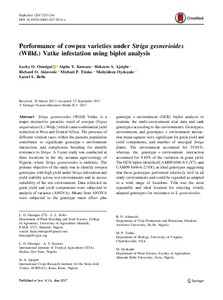| dc.contributor.author | Omoigui, L.O. |
| dc.contributor.author | Kamara, A.Y. |
| dc.contributor.author | Ajeigbe, Hakeem A. |
| dc.contributor.author | Akinwale, R.O. |
| dc.contributor.author | Timko, M.P. |
| dc.contributor.author | Oyekunle, M. |
| dc.contributor.author | Bello, L.L. |
| dc.date.accessioned | 2019-12-04T11:10:48Z |
| dc.date.available | 2019-12-04T11:10:48Z |
| dc.date.issued | 2017-11 |
| dc.identifier.citation | Omoigui, L.O., Kamara, A.Y., Ajeigbe, H.A., Akinwale, R.O., Timko, M.P., Oyekunle, M. & Bello, L.L. (2017). Performance of cowpea varieties under Striga gesnerioides (Willd.) Vatke infestation using biplot analysis. Euphytica, 213(11), 244. |
| dc.identifier.issn | 0014-2336 |
| dc.identifier.uri | https://hdl.handle.net/20.500.12478/2271 |
| dc.description | Published online: 10 October 2017 |
| dc.description.abstract | Striga gesnerioides (Willd) Vatke, is a major destructive parasitic weed of cowpea (Vigna unguiculata (L.) Walp.) which causes substantial yield reduction in West and Central Africa. The presence of different virulent races within the parasite population contributes to significant genotype × environment interaction, and complicates breeding for durable resistance to Striga. A 3-year study was conducted at three locations in the dry savanna agro-ecology of Nigeria, where Striga gesnerioides is endemic. The primary objective of the study was to identify cowpea genotypes with high yield under Striga infestation and yield stability across test environments and to access suitability of the test environment. Data collected on grain yield and yield components were subjected to analysis of variance (ANOVA). Means from ANOVA were subjected to the genotype main effect plus genotype × environment (GGE) biplot analysis to examine the multi-environment trial data and rank genotypes according to the environments. Genotypes, environment, and genotypes × environment interaction mean squares were significant for grain yield and yield components, and number of emerged Striga plants. The environment accounted for 35.01%, whereas the genotype × environment interaction accounted for 9.10% of the variation in grain yield. The GGE biplot identified UAM09 1046-6-1 (V7), and UAM09 1046-6-2 (V8), as ideal genotypes suggesting that these genotypes performed relatively well in all study environments and could be regarded as adapted to a wide range of locations. Tilla was the most repeatable and ideal location for selecting widely adapted genotypes for resistance to S. gesnerioides. |
| dc.description.sponsorship | Kirkhouse Trust |
| dc.format.extent | 1-16 |
| dc.language.iso | en |
| dc.subject | Cowpeas |
| dc.subject | Analysis |
| dc.subject | Vigna Unguiculata |
| dc.subject | Striga Infestation |
| dc.subject | Genotypes |
| dc.subject | Biplot Analysi |
| dc.subject | Striga Gesnerioides |
| dc.subject | Gge |
| dc.title | Performance of cowpea varieties under Striga gesnerioides (Willd.) Vatke infestation using biplot analysis |
| dc.type | Journal Article |
| dc.description.version | Peer Review |
| cg.contributor.crp | Grain Legumes |
| cg.contributor.crp | Maize |
| cg.contributor.crp | Water, Land and Ecosystems |
| cg.contributor.affiliation | University of Agriculture, Makurdi |
| cg.contributor.affiliation | International Institute of Tropical Agriculture |
| cg.contributor.affiliation | International Crops Research Institute for the Semi-Arid Tropics |
| cg.contributor.affiliation | Obafemi Awolowo University |
| cg.contributor.affiliation | University of Virginia |
| cg.contributor.affiliation | Ahmadu Bello University |
| cg.coverage.region | Africa |
| cg.coverage.region | West Africa |
| cg.coverage.country | Nigeria |
| cg.isijournal | ISI Journal |
| cg.authorship.types | CGIAR and developing country institute |
| cg.iitasubject | Cowpea |
| cg.iitasubject | Genetic Improvement |
| cg.iitasubject | Grain Legumes |
| cg.iitasubject | Plant Genetic Resources |
| cg.journal | Euphytica |
| cg.howpublished | Formally Published |
| cg.accessibilitystatus | Limited Access |
| local.dspaceid | 91848 |
| cg.targetaudience | Scientists |
| cg.identifier.doi | http://dx.doi.org/10.1007/s10681-017-2034-x |

